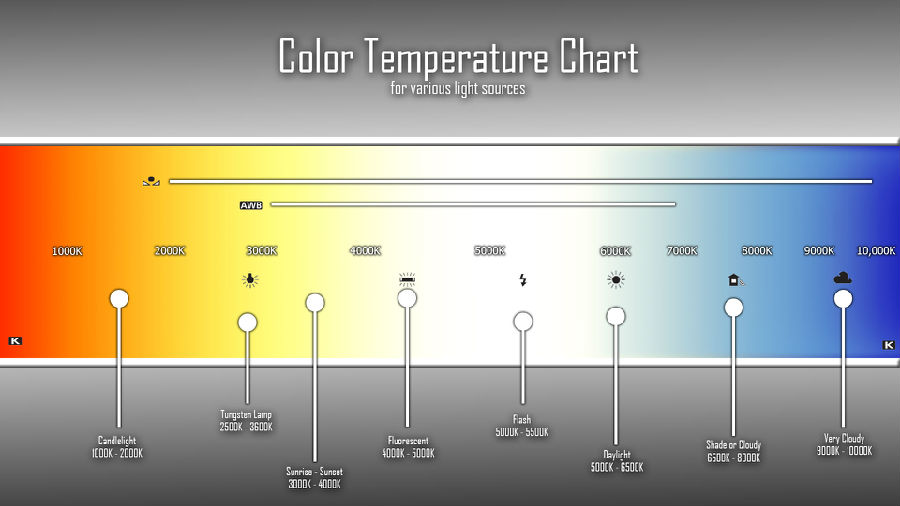How The Color Temperature Relates With LED Lighting
Time:2016-03-02 Views:10809 Compile:SUNPER
Does the color temperature have anything to do with the LED lighting? Well, if answer is yes, what is its significance to LED lighting? Okay, what kind of lighting do you like, warmer or cooler one? Another question to ask is why Americans do prefer warm white and not the other? The above questions are meant to guide us throughout this topic.
People who are brought up in areas where incandescent bulbs at 2700 kelvins are used, usually grow well and their skin tone is made to look healthier. In contradiction to this, those people who are brought up cooler northern climates also prefer the warmer colors while those in the warmer southern climates do prefer the cooler colors. This is the irony seen due to different climates in different areas and what residents of each place wish to have. With that, below is a complete color temperature chart resized 600.

The LED interior Color Temperatures
The LED interior products are normally given in a range from warm white, neutral to the daylight white. Warmer substance such as 2700 kelvins usually give yellowish hues and this is good for the skin tones. However, it is not good for the commercial retail applications as well as the illumination of the fabric s and foods. This is where the rich saturated colors are found. Such colors include orange, red and purple color. The LED Troffers sold are given at 3500, 4000 and 5000 kelvins.
The Exterior Color Temperature of the LEDs
The LED exterior products are mostly offered in the daylight white range. Cooler substances give a blue hue. Such cooler substances can also distort the color perception. The parking area is given 5200 kelvins while the exterior wallpacks are given from 5000 kelvins to 5700 kelvins.
There are some similarities and differences between the LED HID incandescent bulbs and the fluorescent bulbs. For the incandescent bulbs, they include the following. If you begin with a yellowish light such as a typical incandescent bulb, it will bring out the warmer colors in various objects. There will be more of green and red colors available in the light itself in order to bounce off the object and make it to your eye.
For the fluorescent bulb, if you start with a normal bulb, there will be a higher percentage of the blue color available in order to bounce off the object. The additional blue rings are called the cooler colors and is where the light bounces.
The above differences within the light sources do explain a common observation as to why the incandescent light is always more flattering to people compared to the fluorescent light. This is the same reason as to why the grocery stores avoid using the standard fluorescent bulbs near vegetables and fruits. Generally, the different light sources usually bring different looks. The differences explain why colors do change once the color temperature or light source is changed.
Most objects have different colors under the daylight when the incandescent light is being used. The same objects will have a different color if a fluorescent bulb is used. In addition to this, things have various colors during the different times of the day.
Light sources and colors
By using the LED light sources, dialing up of various colors of white in the white light range is possible. Also, the ability of any light source to display or render color depends on the amount of the power it emits or radiates in different regions of the color spectrum.

The full color spectrum
The LED is marketed as full color spectrum light source. The other terms found in the market today are spectrally enhanced lighting. The high quality LED light sources, luminaires and fixtures usually emit or radiate light wavelength that is representative of what we normally see in the natural sunlight where there is full color spectrum.
It is possible for light to be brighter than what is measured. Keeping in mind that the color of the light has inherent qualities that are not fully understood, it is good to know how eyes perceive the light quality. Well, the recent discoveries in the vision science inform us that there is much light than what is measured. Nowadays, people have started realizing the benefits for using the LED to generate the full color spectrum of the light.
For the full color spectrum which is good for circadian rhythm, use a full color light source such as LED with spectra as it will improve the visual acuity. It also has positive effects on the internal clock of the body and makes the environment to have a better lighting.
More Posts
▇ Improving employee productivity by lighting color temperature
▇ Color Temperature and Its Importance
How To Calculate The Lighting Costs For Metal Halide Fixtures
Next:Recent Studies In US Proofing That Residents Still Need More Awareness On Energy Efficiency Educatio
User comments
Your current input 0 characters(Reply for at least 6 characters)。
Online Services

Mobile: +86 18938902515 (Mr.Allen)
Tel:+86 755 23159099
Fax:+86 755 61673151
E-mail: sales@sunper.net
zip code: 518108











